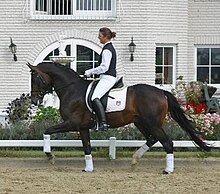Center of balance (horse)
The location of the horse's center of balance depends on a combination of speed and degree of collection.
For a standing or quietly walking horse, it is slightly behind the heart girth and below the withers.
If a horse is moving at a trot or canter, the center of balance shifts slightly forward, and it moves even more forward when the horse is galloping or jumping.
For movements such as a rein back or the levade, the center of balance of horse and rider may be further back than at a standstill, due to the shift of weight and balance to the hindquarters of the horse Accordingly, a saddle designed for a specific discipline will attempt to place a rider naturally at the most suitable position for the anticipated activity of the horse.
[1] For example, a "close contact" style of English saddle, designed for show jumping, places the rider's seat farther forward than does a dressage style English saddle.


